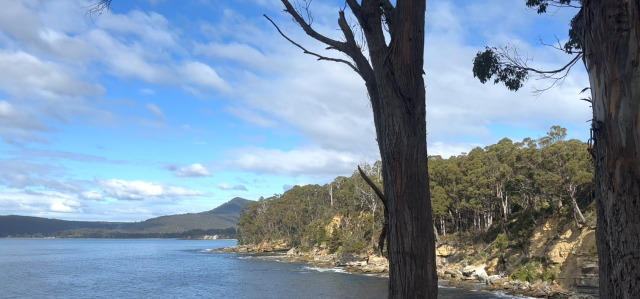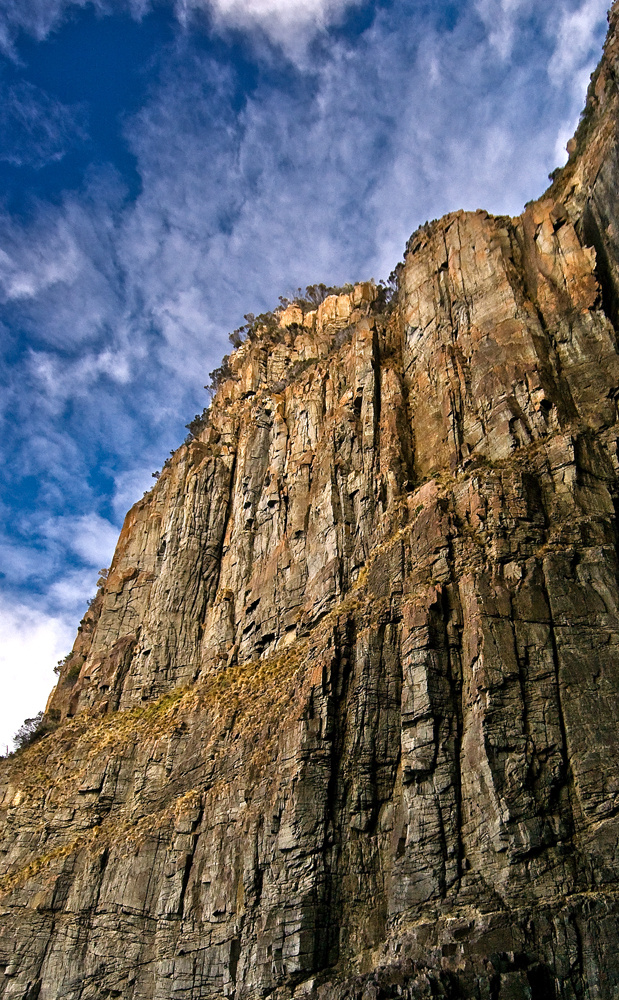Earth is at least 4.5 billion years old. You won’t find any fossils in the older sandstone at Adventure Bay. Some of this sandstone – a sedimentary rock - was formed at least before life emerged on Earth. Sedimentary rock you can pick because you get the layers of rock – you can see horizontal lines through the rock as it has been layered over time. But these rocks weren’t in this position when they were first formed. This was part of the ancient continent of Gondwanaland. When it broke away from Gondwana these were remnants covered by other types of rock - dolerite, sandstones and siltstones and other rocks with fossils in them.

That archway at Mars bluff, for example, is basalt which filled a crack in the rock. That formed probably about 60 million years ago. This is younger rock that formed when life on Earth already existed – so you can actually see fossils embedded in the rocks there.

The lava that millions of years ago eventually formed what are now dolerite rocks mainly took the form of flows across the landscapes, not volcanic eruptions, but often more gentle flows. As they hardened and formed dolerite rock formations, the movement of the tectonic plates then subsequently pushed these formations up into surrounding rocks.
You can also see as you look at the coastline at the southern end of Adventure Bay, areas of wave cut platform at the front of the sandstone. You then get what you call ‘mass wasting’ where great clumps of rock fall off. The rock then disintegrates over time and get washed off, with really interesting holes getting washed into and through the rocks.

You won’t find any fossils in the older sandstone at Adventure Bay. Some of this sandstone – a sedimentary rock - was formed at least before life emerged on Earth.

Bob Graham
Earth is at least 4.5 billion years old. You won’t find any fossils in the older sandstone at Adventure Bay. Some of this sandstone – a sedimentary rock - was formed at least before life emerged on Earth. Sedimentary rock you can pick because you get the layers of rock – you can see horizontal lines through the rock as it has been layered over time. But these rocks weren’t in this position when they were first formed. This was part of the ancient continent of Gondwanaland. When it broke away from Gondwana these were remnants covered by other types of rock - dolerite, sandstones and siltstones and other rocks with fossils in them.

That archway at Mars bluff, for example, is basalt which filled a crack in the rock. That formed probably about 60 million years ago. This is younger rock that formed when life on Earth already existed – so you can actually see fossils embedded in the rocks there.

The lava that millions of years ago eventually formed what are now dolerite rocks mainly took the form of flows across the landscapes, not volcanic eruptions, but often more gentle flows. As they hardened and formed dolerite rock formations, the movement of the tectonic plates then subsequently pushed these formations up into surrounding rocks.
You can also see as you look at the coastline at the southern end of Adventure Bay, areas of wave cut platform at the front of the sandstone. You then get what you call ‘mass wasting’ where great clumps of rock fall off. The rock then disintegrates over time and get washed off, with really interesting holes getting washed into and through the rocks.

You won’t find any fossils in the older sandstone at Adventure Bay. Some of this sandstone – a sedimentary rock - was formed at least before life emerged on Earth.
You might like...

Geological History of Bruny Island

Why are beaches curved?

The fascinating beaches of Bruny

Bruny - two islands joined by a Tombolo?
Newsletter
Sign up to keep in touch with articles, updates, events or news from Kuno, your platform for nature
